BUSN20017 Effective Communication: A Personal Reflection Essay
VerifiedAdded on 2023/06/11
|15
|4136
|396
Essay
AI Summary
This essay presents a self-reflection analysis of the author's communication skills, based on five diagnostic tools that assess interpersonal competence. It identifies two major communication issues: intercultural incompetence and nonverbal immediacy. The essay includes a literature review on these issues, highlighting their significance and the author's personal experiences with them. An action plan with a Gantt chart is designed to address the identified issues. The diagnostic tools used include the Self-perceived Communication Competence Scale (SPCC), Nonverbal Immediacy Scale Self Report (NIS-S), Personal Report of Intercultural Communication Apprehension (PRICA), Talkaholic Scale, and the Tolerance and Disagreement test. The essay provides examples from the author's professional life where these communication issues have negatively impacted their performance and the organization's revenue, emphasizing the need for improvement and cultural competence in multicultural workplaces.
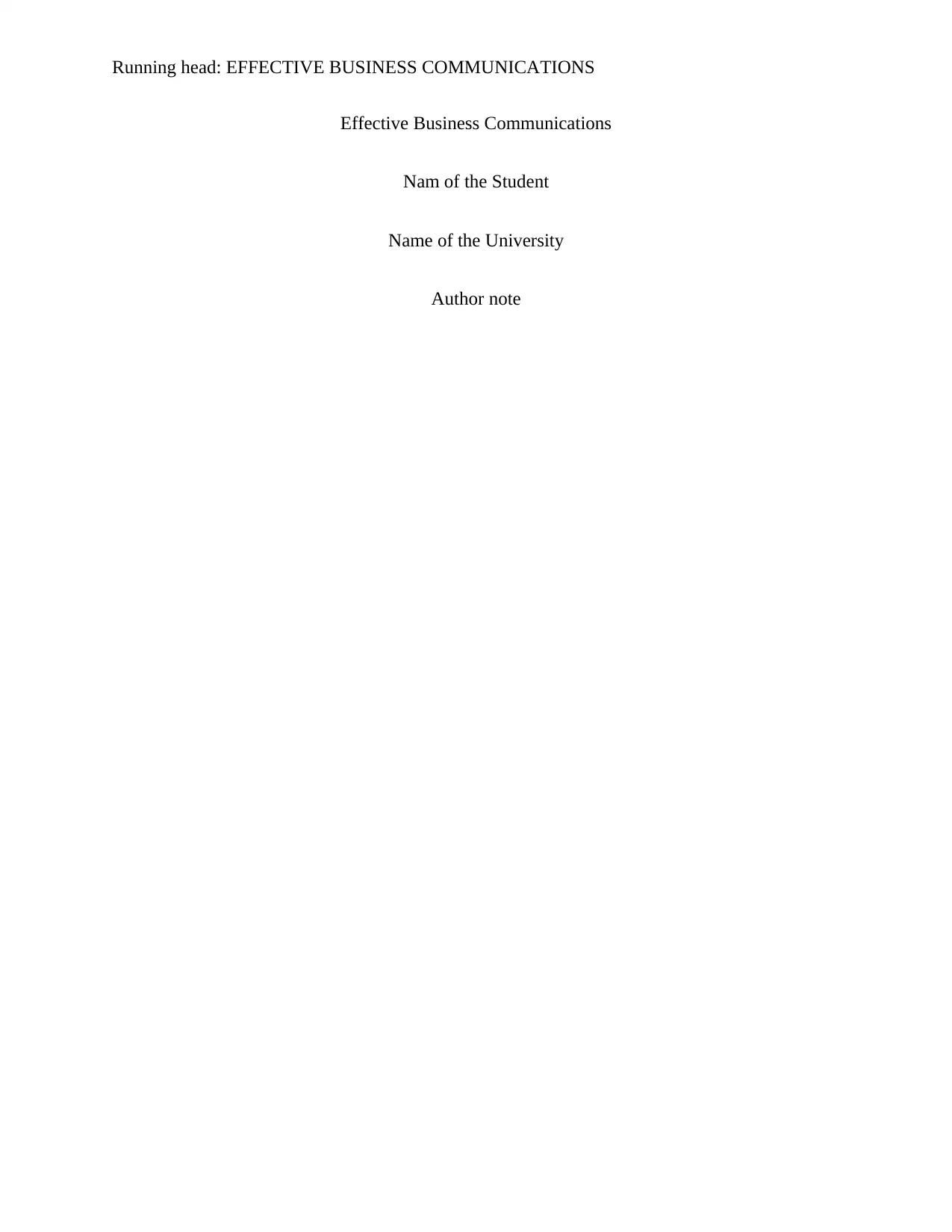
Running head: EFFECTIVE BUSINESS COMMUNICATIONS
Effective Business Communications
Nam of the Student
Name of the University
Author note
Effective Business Communications
Nam of the Student
Name of the University
Author note
Paraphrase This Document
Need a fresh take? Get an instant paraphrase of this document with our AI Paraphraser
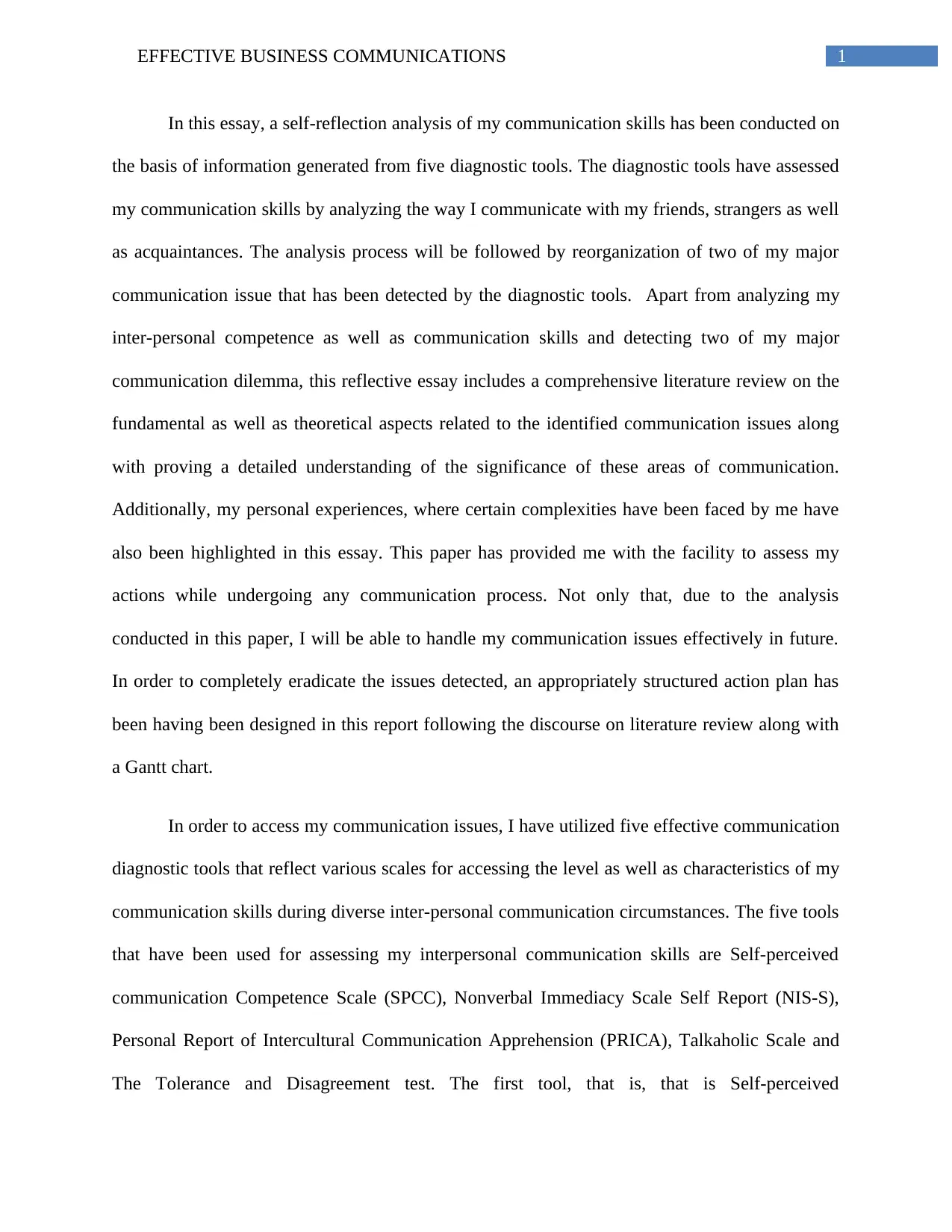
1EFFECTIVE BUSINESS COMMUNICATIONS
In this essay, a self-reflection analysis of my communication skills has been conducted on
the basis of information generated from five diagnostic tools. The diagnostic tools have assessed
my communication skills by analyzing the way I communicate with my friends, strangers as well
as acquaintances. The analysis process will be followed by reorganization of two of my major
communication issue that has been detected by the diagnostic tools. Apart from analyzing my
inter-personal competence as well as communication skills and detecting two of my major
communication dilemma, this reflective essay includes a comprehensive literature review on the
fundamental as well as theoretical aspects related to the identified communication issues along
with proving a detailed understanding of the significance of these areas of communication.
Additionally, my personal experiences, where certain complexities have been faced by me have
also been highlighted in this essay. This paper has provided me with the facility to assess my
actions while undergoing any communication process. Not only that, due to the analysis
conducted in this paper, I will be able to handle my communication issues effectively in future.
In order to completely eradicate the issues detected, an appropriately structured action plan has
been having been designed in this report following the discourse on literature review along with
a Gantt chart.
In order to access my communication issues, I have utilized five effective communication
diagnostic tools that reflect various scales for accessing the level as well as characteristics of my
communication skills during diverse inter-personal communication circumstances. The five tools
that have been used for assessing my interpersonal communication skills are Self-perceived
communication Competence Scale (SPCC), Nonverbal Immediacy Scale Self Report (NIS-S),
Personal Report of Intercultural Communication Apprehension (PRICA), Talkaholic Scale and
The Tolerance and Disagreement test. The first tool, that is, that is Self-perceived
In this essay, a self-reflection analysis of my communication skills has been conducted on
the basis of information generated from five diagnostic tools. The diagnostic tools have assessed
my communication skills by analyzing the way I communicate with my friends, strangers as well
as acquaintances. The analysis process will be followed by reorganization of two of my major
communication issue that has been detected by the diagnostic tools. Apart from analyzing my
inter-personal competence as well as communication skills and detecting two of my major
communication dilemma, this reflective essay includes a comprehensive literature review on the
fundamental as well as theoretical aspects related to the identified communication issues along
with proving a detailed understanding of the significance of these areas of communication.
Additionally, my personal experiences, where certain complexities have been faced by me have
also been highlighted in this essay. This paper has provided me with the facility to assess my
actions while undergoing any communication process. Not only that, due to the analysis
conducted in this paper, I will be able to handle my communication issues effectively in future.
In order to completely eradicate the issues detected, an appropriately structured action plan has
been having been designed in this report following the discourse on literature review along with
a Gantt chart.
In order to access my communication issues, I have utilized five effective communication
diagnostic tools that reflect various scales for accessing the level as well as characteristics of my
communication skills during diverse inter-personal communication circumstances. The five tools
that have been used for assessing my interpersonal communication skills are Self-perceived
communication Competence Scale (SPCC), Nonverbal Immediacy Scale Self Report (NIS-S),
Personal Report of Intercultural Communication Apprehension (PRICA), Talkaholic Scale and
The Tolerance and Disagreement test. The first tool, that is, that is Self-perceived
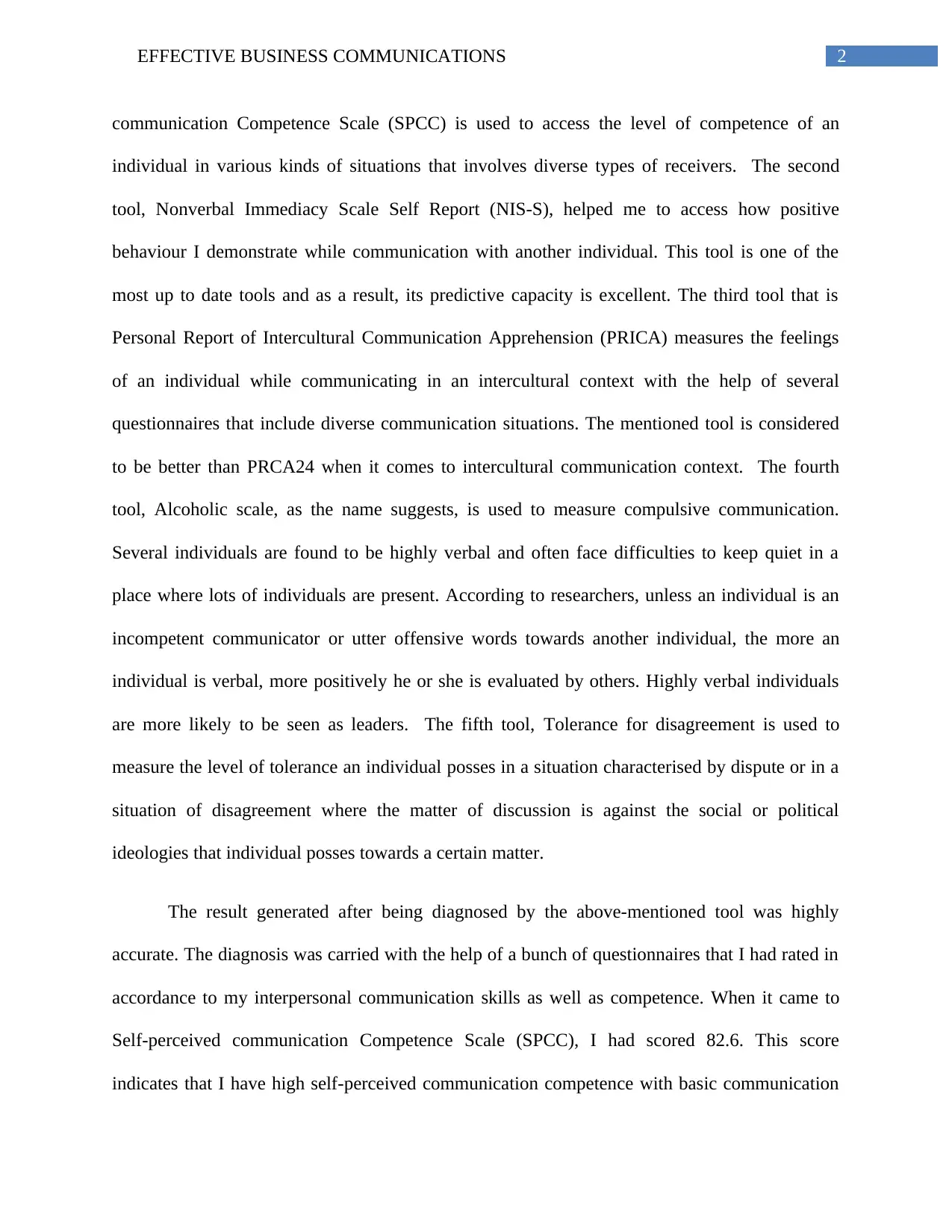
2EFFECTIVE BUSINESS COMMUNICATIONS
communication Competence Scale (SPCC) is used to access the level of competence of an
individual in various kinds of situations that involves diverse types of receivers. The second
tool, Nonverbal Immediacy Scale Self Report (NIS-S), helped me to access how positive
behaviour I demonstrate while communication with another individual. This tool is one of the
most up to date tools and as a result, its predictive capacity is excellent. The third tool that is
Personal Report of Intercultural Communication Apprehension (PRICA) measures the feelings
of an individual while communicating in an intercultural context with the help of several
questionnaires that include diverse communication situations. The mentioned tool is considered
to be better than PRCA24 when it comes to intercultural communication context. The fourth
tool, Alcoholic scale, as the name suggests, is used to measure compulsive communication.
Several individuals are found to be highly verbal and often face difficulties to keep quiet in a
place where lots of individuals are present. According to researchers, unless an individual is an
incompetent communicator or utter offensive words towards another individual, the more an
individual is verbal, more positively he or she is evaluated by others. Highly verbal individuals
are more likely to be seen as leaders. The fifth tool, Tolerance for disagreement is used to
measure the level of tolerance an individual posses in a situation characterised by dispute or in a
situation of disagreement where the matter of discussion is against the social or political
ideologies that individual posses towards a certain matter.
The result generated after being diagnosed by the above-mentioned tool was highly
accurate. The diagnosis was carried with the help of a bunch of questionnaires that I had rated in
accordance to my interpersonal communication skills as well as competence. When it came to
Self-perceived communication Competence Scale (SPCC), I had scored 82.6. This score
indicates that I have high self-perceived communication competence with basic communication
communication Competence Scale (SPCC) is used to access the level of competence of an
individual in various kinds of situations that involves diverse types of receivers. The second
tool, Nonverbal Immediacy Scale Self Report (NIS-S), helped me to access how positive
behaviour I demonstrate while communication with another individual. This tool is one of the
most up to date tools and as a result, its predictive capacity is excellent. The third tool that is
Personal Report of Intercultural Communication Apprehension (PRICA) measures the feelings
of an individual while communicating in an intercultural context with the help of several
questionnaires that include diverse communication situations. The mentioned tool is considered
to be better than PRCA24 when it comes to intercultural communication context. The fourth
tool, Alcoholic scale, as the name suggests, is used to measure compulsive communication.
Several individuals are found to be highly verbal and often face difficulties to keep quiet in a
place where lots of individuals are present. According to researchers, unless an individual is an
incompetent communicator or utter offensive words towards another individual, the more an
individual is verbal, more positively he or she is evaluated by others. Highly verbal individuals
are more likely to be seen as leaders. The fifth tool, Tolerance for disagreement is used to
measure the level of tolerance an individual posses in a situation characterised by dispute or in a
situation of disagreement where the matter of discussion is against the social or political
ideologies that individual posses towards a certain matter.
The result generated after being diagnosed by the above-mentioned tool was highly
accurate. The diagnosis was carried with the help of a bunch of questionnaires that I had rated in
accordance to my interpersonal communication skills as well as competence. When it came to
Self-perceived communication Competence Scale (SPCC), I had scored 82.6. This score
indicates that I have high self-perceived communication competence with basic communication
⊘ This is a preview!⊘
Do you want full access?
Subscribe today to unlock all pages.

Trusted by 1+ million students worldwide
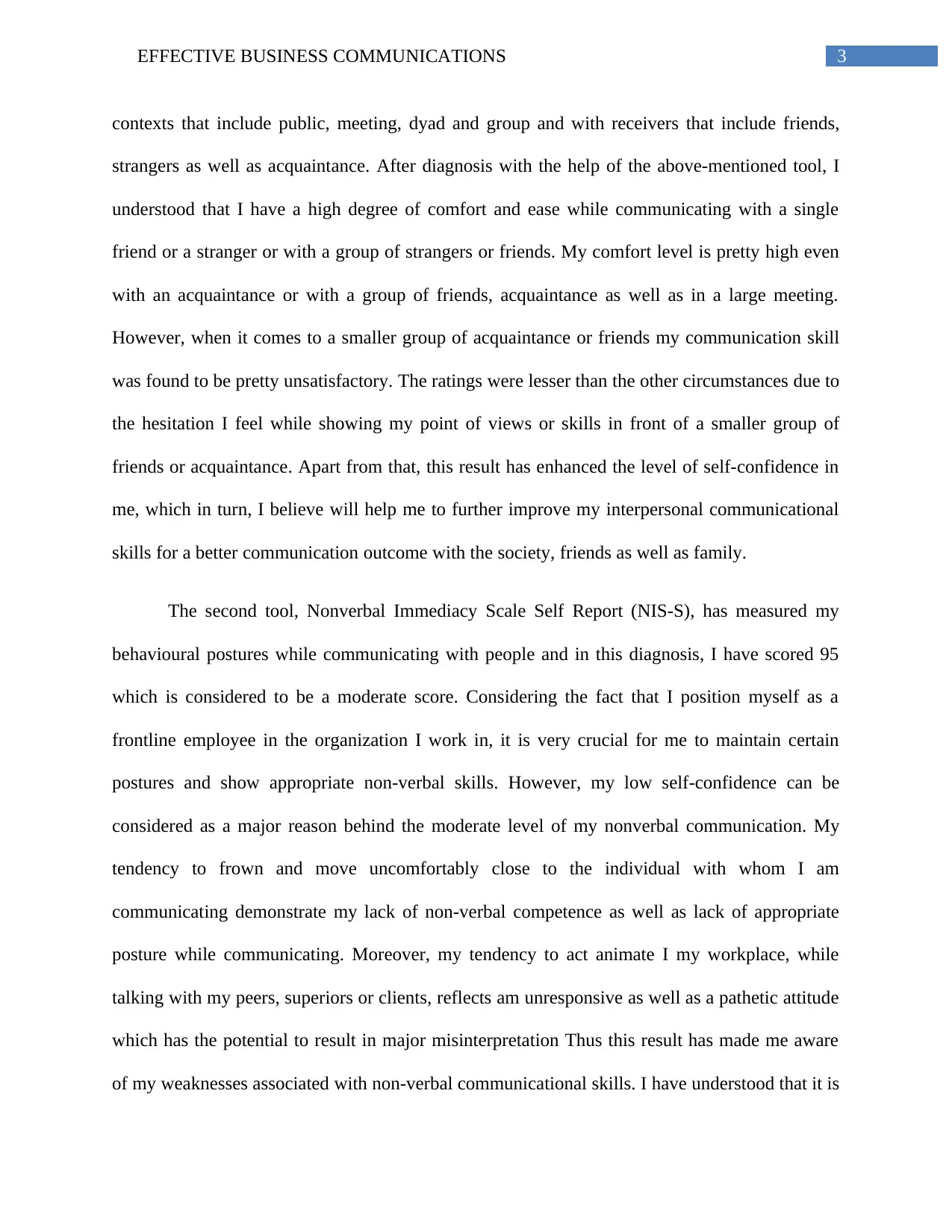
3EFFECTIVE BUSINESS COMMUNICATIONS
contexts that include public, meeting, dyad and group and with receivers that include friends,
strangers as well as acquaintance. After diagnosis with the help of the above-mentioned tool, I
understood that I have a high degree of comfort and ease while communicating with a single
friend or a stranger or with a group of strangers or friends. My comfort level is pretty high even
with an acquaintance or with a group of friends, acquaintance as well as in a large meeting.
However, when it comes to a smaller group of acquaintance or friends my communication skill
was found to be pretty unsatisfactory. The ratings were lesser than the other circumstances due to
the hesitation I feel while showing my point of views or skills in front of a smaller group of
friends or acquaintance. Apart from that, this result has enhanced the level of self-confidence in
me, which in turn, I believe will help me to further improve my interpersonal communicational
skills for a better communication outcome with the society, friends as well as family.
The second tool, Nonverbal Immediacy Scale Self Report (NIS-S), has measured my
behavioural postures while communicating with people and in this diagnosis, I have scored 95
which is considered to be a moderate score. Considering the fact that I position myself as a
frontline employee in the organization I work in, it is very crucial for me to maintain certain
postures and show appropriate non-verbal skills. However, my low self-confidence can be
considered as a major reason behind the moderate level of my nonverbal communication. My
tendency to frown and move uncomfortably close to the individual with whom I am
communicating demonstrate my lack of non-verbal competence as well as lack of appropriate
posture while communicating. Moreover, my tendency to act animate I my workplace, while
talking with my peers, superiors or clients, reflects am unresponsive as well as a pathetic attitude
which has the potential to result in major misinterpretation Thus this result has made me aware
of my weaknesses associated with non-verbal communicational skills. I have understood that it is
contexts that include public, meeting, dyad and group and with receivers that include friends,
strangers as well as acquaintance. After diagnosis with the help of the above-mentioned tool, I
understood that I have a high degree of comfort and ease while communicating with a single
friend or a stranger or with a group of strangers or friends. My comfort level is pretty high even
with an acquaintance or with a group of friends, acquaintance as well as in a large meeting.
However, when it comes to a smaller group of acquaintance or friends my communication skill
was found to be pretty unsatisfactory. The ratings were lesser than the other circumstances due to
the hesitation I feel while showing my point of views or skills in front of a smaller group of
friends or acquaintance. Apart from that, this result has enhanced the level of self-confidence in
me, which in turn, I believe will help me to further improve my interpersonal communicational
skills for a better communication outcome with the society, friends as well as family.
The second tool, Nonverbal Immediacy Scale Self Report (NIS-S), has measured my
behavioural postures while communicating with people and in this diagnosis, I have scored 95
which is considered to be a moderate score. Considering the fact that I position myself as a
frontline employee in the organization I work in, it is very crucial for me to maintain certain
postures and show appropriate non-verbal skills. However, my low self-confidence can be
considered as a major reason behind the moderate level of my nonverbal communication. My
tendency to frown and move uncomfortably close to the individual with whom I am
communicating demonstrate my lack of non-verbal competence as well as lack of appropriate
posture while communicating. Moreover, my tendency to act animate I my workplace, while
talking with my peers, superiors or clients, reflects am unresponsive as well as a pathetic attitude
which has the potential to result in major misinterpretation Thus this result has made me aware
of my weaknesses associated with non-verbal communicational skills. I have understood that it is
Paraphrase This Document
Need a fresh take? Get an instant paraphrase of this document with our AI Paraphraser
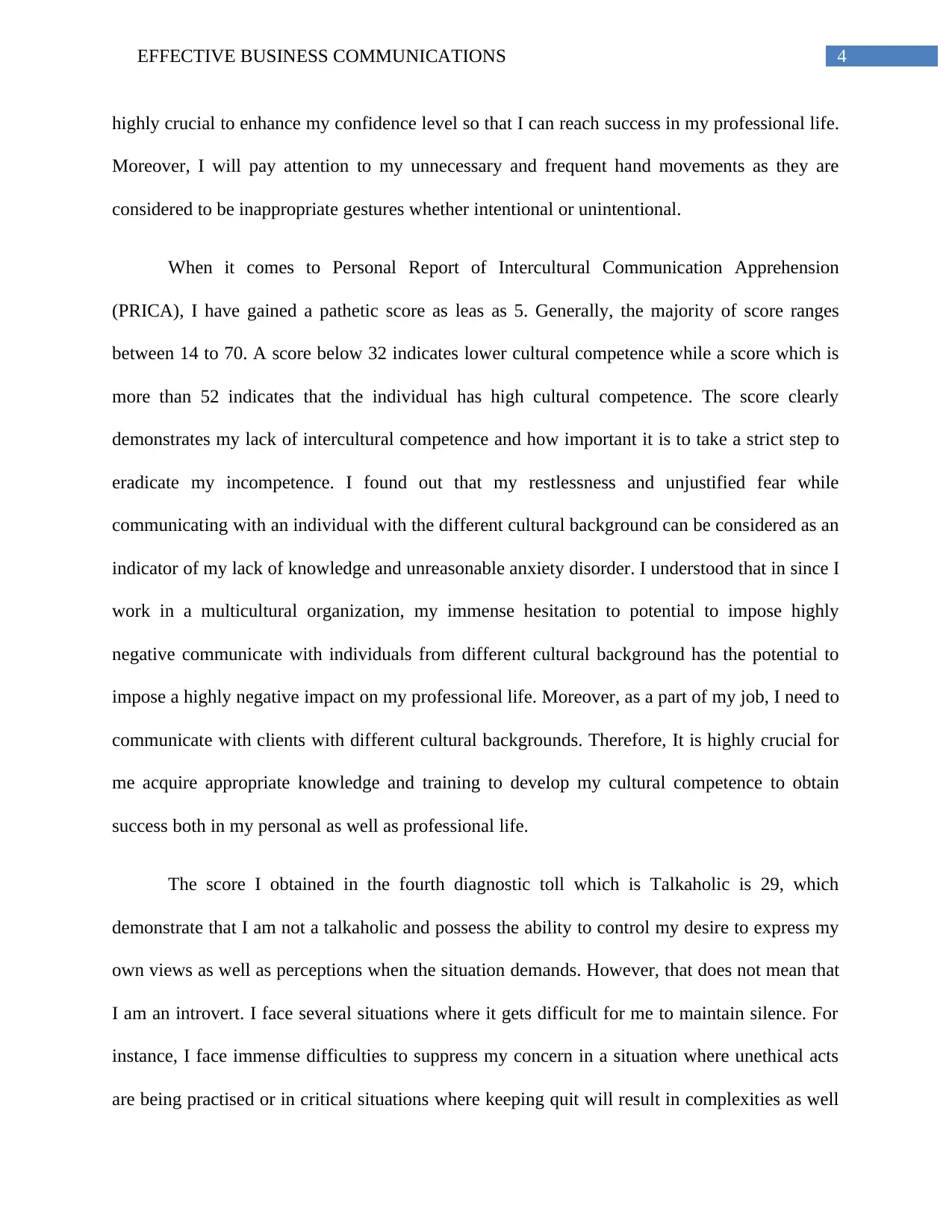
4EFFECTIVE BUSINESS COMMUNICATIONS
highly crucial to enhance my confidence level so that I can reach success in my professional life.
Moreover, I will pay attention to my unnecessary and frequent hand movements as they are
considered to be inappropriate gestures whether intentional or unintentional.
When it comes to Personal Report of Intercultural Communication Apprehension
(PRICA), I have gained a pathetic score as leas as 5. Generally, the majority of score ranges
between 14 to 70. A score below 32 indicates lower cultural competence while a score which is
more than 52 indicates that the individual has high cultural competence. The score clearly
demonstrates my lack of intercultural competence and how important it is to take a strict step to
eradicate my incompetence. I found out that my restlessness and unjustified fear while
communicating with an individual with the different cultural background can be considered as an
indicator of my lack of knowledge and unreasonable anxiety disorder. I understood that in since I
work in a multicultural organization, my immense hesitation to potential to impose highly
negative communicate with individuals from different cultural background has the potential to
impose a highly negative impact on my professional life. Moreover, as a part of my job, I need to
communicate with clients with different cultural backgrounds. Therefore, It is highly crucial for
me acquire appropriate knowledge and training to develop my cultural competence to obtain
success both in my personal as well as professional life.
The score I obtained in the fourth diagnostic toll which is Talkaholic is 29, which
demonstrate that I am not a talkaholic and possess the ability to control my desire to express my
own views as well as perceptions when the situation demands. However, that does not mean that
I am an introvert. I face several situations where it gets difficult for me to maintain silence. For
instance, I face immense difficulties to suppress my concern in a situation where unethical acts
are being practised or in critical situations where keeping quit will result in complexities as well
highly crucial to enhance my confidence level so that I can reach success in my professional life.
Moreover, I will pay attention to my unnecessary and frequent hand movements as they are
considered to be inappropriate gestures whether intentional or unintentional.
When it comes to Personal Report of Intercultural Communication Apprehension
(PRICA), I have gained a pathetic score as leas as 5. Generally, the majority of score ranges
between 14 to 70. A score below 32 indicates lower cultural competence while a score which is
more than 52 indicates that the individual has high cultural competence. The score clearly
demonstrates my lack of intercultural competence and how important it is to take a strict step to
eradicate my incompetence. I found out that my restlessness and unjustified fear while
communicating with an individual with the different cultural background can be considered as an
indicator of my lack of knowledge and unreasonable anxiety disorder. I understood that in since I
work in a multicultural organization, my immense hesitation to potential to impose highly
negative communicate with individuals from different cultural background has the potential to
impose a highly negative impact on my professional life. Moreover, as a part of my job, I need to
communicate with clients with different cultural backgrounds. Therefore, It is highly crucial for
me acquire appropriate knowledge and training to develop my cultural competence to obtain
success both in my personal as well as professional life.
The score I obtained in the fourth diagnostic toll which is Talkaholic is 29, which
demonstrate that I am not a talkaholic and possess the ability to control my desire to express my
own views as well as perceptions when the situation demands. However, that does not mean that
I am an introvert. I face several situations where it gets difficult for me to maintain silence. For
instance, I face immense difficulties to suppress my concern in a situation where unethical acts
are being practised or in critical situations where keeping quit will result in complexities as well
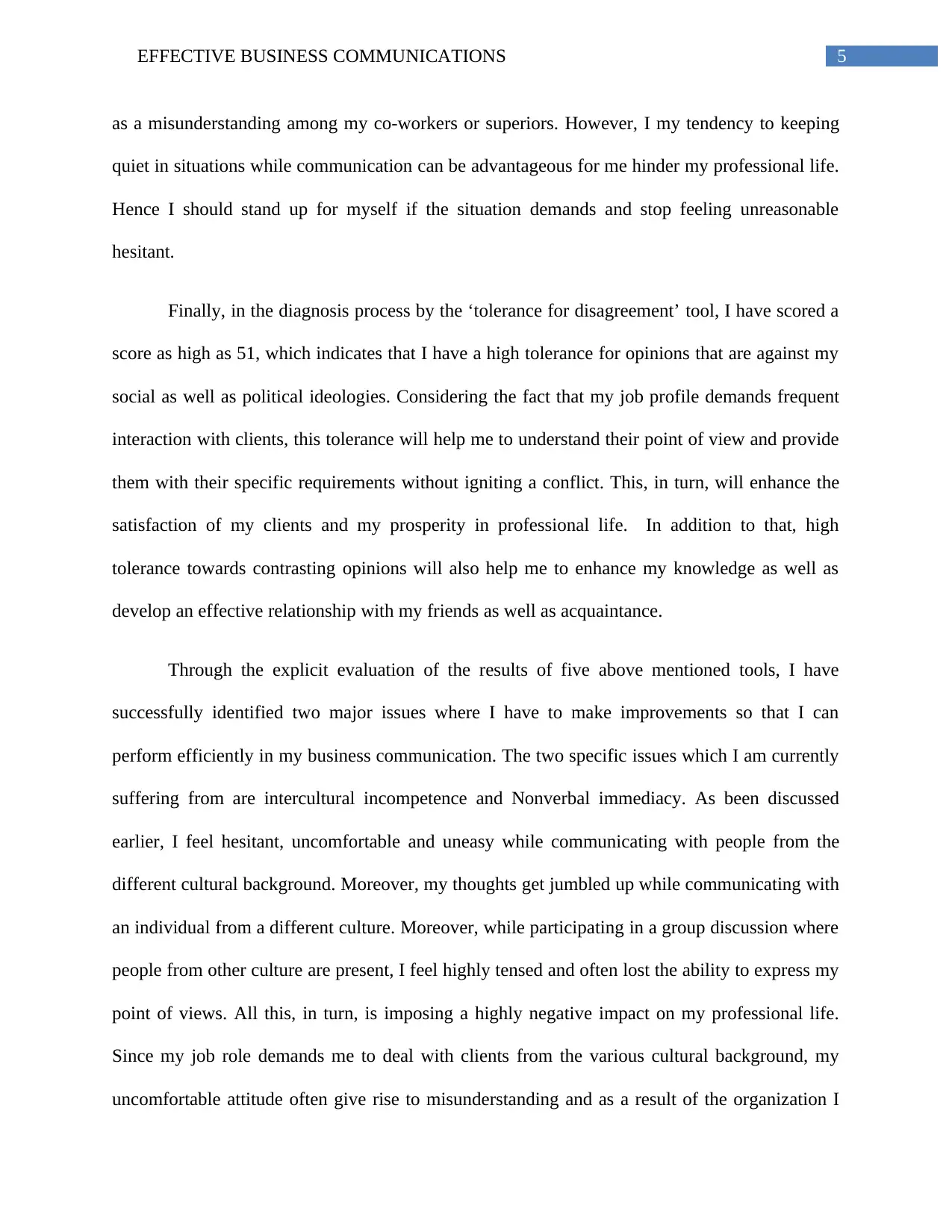
5EFFECTIVE BUSINESS COMMUNICATIONS
as a misunderstanding among my co-workers or superiors. However, I my tendency to keeping
quiet in situations while communication can be advantageous for me hinder my professional life.
Hence I should stand up for myself if the situation demands and stop feeling unreasonable
hesitant.
Finally, in the diagnosis process by the ‘tolerance for disagreement’ tool, I have scored a
score as high as 51, which indicates that I have a high tolerance for opinions that are against my
social as well as political ideologies. Considering the fact that my job profile demands frequent
interaction with clients, this tolerance will help me to understand their point of view and provide
them with their specific requirements without igniting a conflict. This, in turn, will enhance the
satisfaction of my clients and my prosperity in professional life. In addition to that, high
tolerance towards contrasting opinions will also help me to enhance my knowledge as well as
develop an effective relationship with my friends as well as acquaintance.
Through the explicit evaluation of the results of five above mentioned tools, I have
successfully identified two major issues where I have to make improvements so that I can
perform efficiently in my business communication. The two specific issues which I am currently
suffering from are intercultural incompetence and Nonverbal immediacy. As been discussed
earlier, I feel hesitant, uncomfortable and uneasy while communicating with people from the
different cultural background. Moreover, my thoughts get jumbled up while communicating with
an individual from a different culture. Moreover, while participating in a group discussion where
people from other culture are present, I feel highly tensed and often lost the ability to express my
point of views. All this, in turn, is imposing a highly negative impact on my professional life.
Since my job role demands me to deal with clients from the various cultural background, my
uncomfortable attitude often give rise to misunderstanding and as a result of the organization I
as a misunderstanding among my co-workers or superiors. However, I my tendency to keeping
quiet in situations while communication can be advantageous for me hinder my professional life.
Hence I should stand up for myself if the situation demands and stop feeling unreasonable
hesitant.
Finally, in the diagnosis process by the ‘tolerance for disagreement’ tool, I have scored a
score as high as 51, which indicates that I have a high tolerance for opinions that are against my
social as well as political ideologies. Considering the fact that my job profile demands frequent
interaction with clients, this tolerance will help me to understand their point of view and provide
them with their specific requirements without igniting a conflict. This, in turn, will enhance the
satisfaction of my clients and my prosperity in professional life. In addition to that, high
tolerance towards contrasting opinions will also help me to enhance my knowledge as well as
develop an effective relationship with my friends as well as acquaintance.
Through the explicit evaluation of the results of five above mentioned tools, I have
successfully identified two major issues where I have to make improvements so that I can
perform efficiently in my business communication. The two specific issues which I am currently
suffering from are intercultural incompetence and Nonverbal immediacy. As been discussed
earlier, I feel hesitant, uncomfortable and uneasy while communicating with people from the
different cultural background. Moreover, my thoughts get jumbled up while communicating with
an individual from a different culture. Moreover, while participating in a group discussion where
people from other culture are present, I feel highly tensed and often lost the ability to express my
point of views. All this, in turn, is imposing a highly negative impact on my professional life.
Since my job role demands me to deal with clients from the various cultural background, my
uncomfortable attitude often give rise to misunderstanding and as a result of the organization I
⊘ This is a preview!⊘
Do you want full access?
Subscribe today to unlock all pages.

Trusted by 1+ million students worldwide
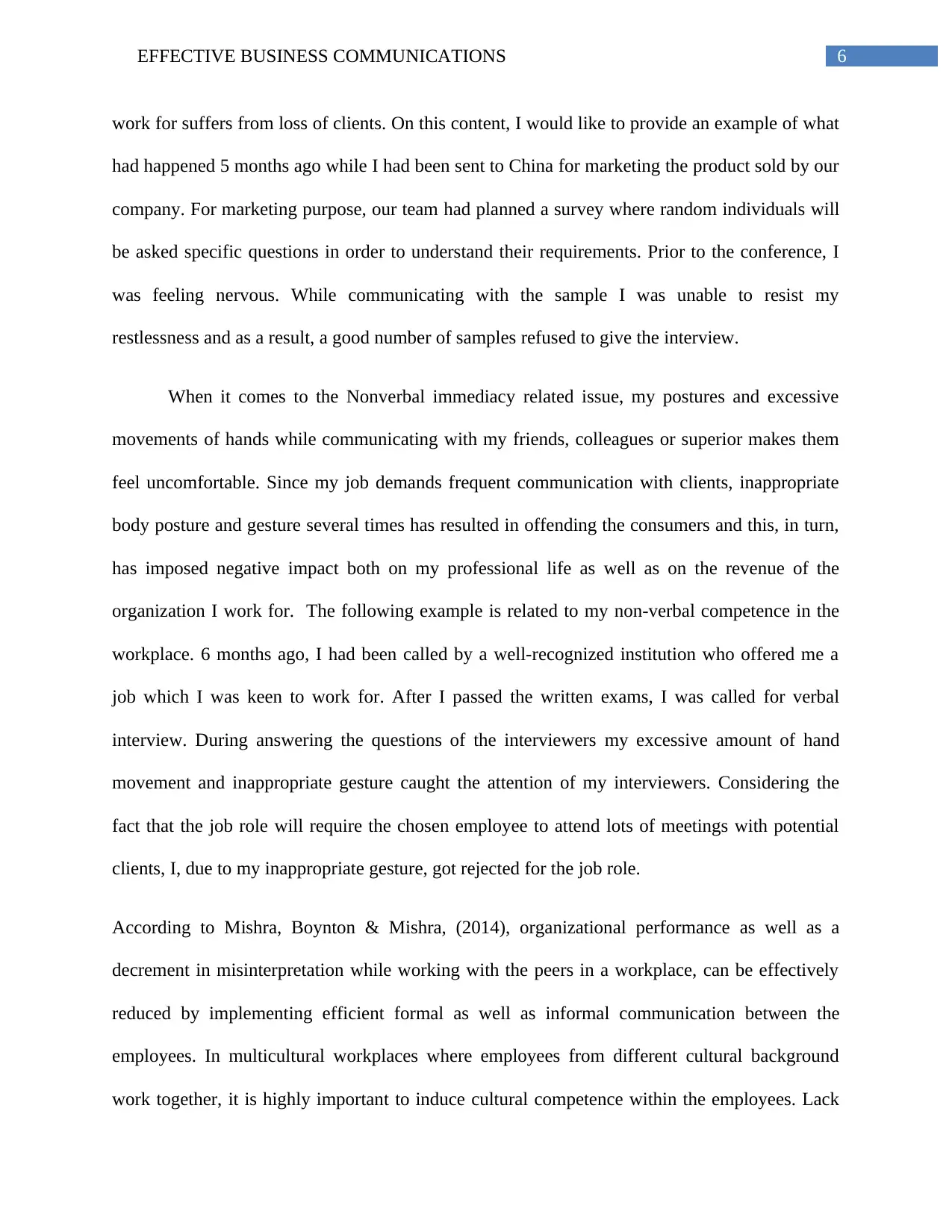
6EFFECTIVE BUSINESS COMMUNICATIONS
work for suffers from loss of clients. On this content, I would like to provide an example of what
had happened 5 months ago while I had been sent to China for marketing the product sold by our
company. For marketing purpose, our team had planned a survey where random individuals will
be asked specific questions in order to understand their requirements. Prior to the conference, I
was feeling nervous. While communicating with the sample I was unable to resist my
restlessness and as a result, a good number of samples refused to give the interview.
When it comes to the Nonverbal immediacy related issue, my postures and excessive
movements of hands while communicating with my friends, colleagues or superior makes them
feel uncomfortable. Since my job demands frequent communication with clients, inappropriate
body posture and gesture several times has resulted in offending the consumers and this, in turn,
has imposed negative impact both on my professional life as well as on the revenue of the
organization I work for. The following example is related to my non-verbal competence in the
workplace. 6 months ago, I had been called by a well-recognized institution who offered me a
job which I was keen to work for. After I passed the written exams, I was called for verbal
interview. During answering the questions of the interviewers my excessive amount of hand
movement and inappropriate gesture caught the attention of my interviewers. Considering the
fact that the job role will require the chosen employee to attend lots of meetings with potential
clients, I, due to my inappropriate gesture, got rejected for the job role.
According to Mishra, Boynton & Mishra, (2014), organizational performance as well as a
decrement in misinterpretation while working with the peers in a workplace, can be effectively
reduced by implementing efficient formal as well as informal communication between the
employees. In multicultural workplaces where employees from different cultural background
work together, it is highly important to induce cultural competence within the employees. Lack
work for suffers from loss of clients. On this content, I would like to provide an example of what
had happened 5 months ago while I had been sent to China for marketing the product sold by our
company. For marketing purpose, our team had planned a survey where random individuals will
be asked specific questions in order to understand their requirements. Prior to the conference, I
was feeling nervous. While communicating with the sample I was unable to resist my
restlessness and as a result, a good number of samples refused to give the interview.
When it comes to the Nonverbal immediacy related issue, my postures and excessive
movements of hands while communicating with my friends, colleagues or superior makes them
feel uncomfortable. Since my job demands frequent communication with clients, inappropriate
body posture and gesture several times has resulted in offending the consumers and this, in turn,
has imposed negative impact both on my professional life as well as on the revenue of the
organization I work for. The following example is related to my non-verbal competence in the
workplace. 6 months ago, I had been called by a well-recognized institution who offered me a
job which I was keen to work for. After I passed the written exams, I was called for verbal
interview. During answering the questions of the interviewers my excessive amount of hand
movement and inappropriate gesture caught the attention of my interviewers. Considering the
fact that the job role will require the chosen employee to attend lots of meetings with potential
clients, I, due to my inappropriate gesture, got rejected for the job role.
According to Mishra, Boynton & Mishra, (2014), organizational performance as well as a
decrement in misinterpretation while working with the peers in a workplace, can be effectively
reduced by implementing efficient formal as well as informal communication between the
employees. In multicultural workplaces where employees from different cultural background
work together, it is highly important to induce cultural competence within the employees. Lack
Paraphrase This Document
Need a fresh take? Get an instant paraphrase of this document with our AI Paraphraser
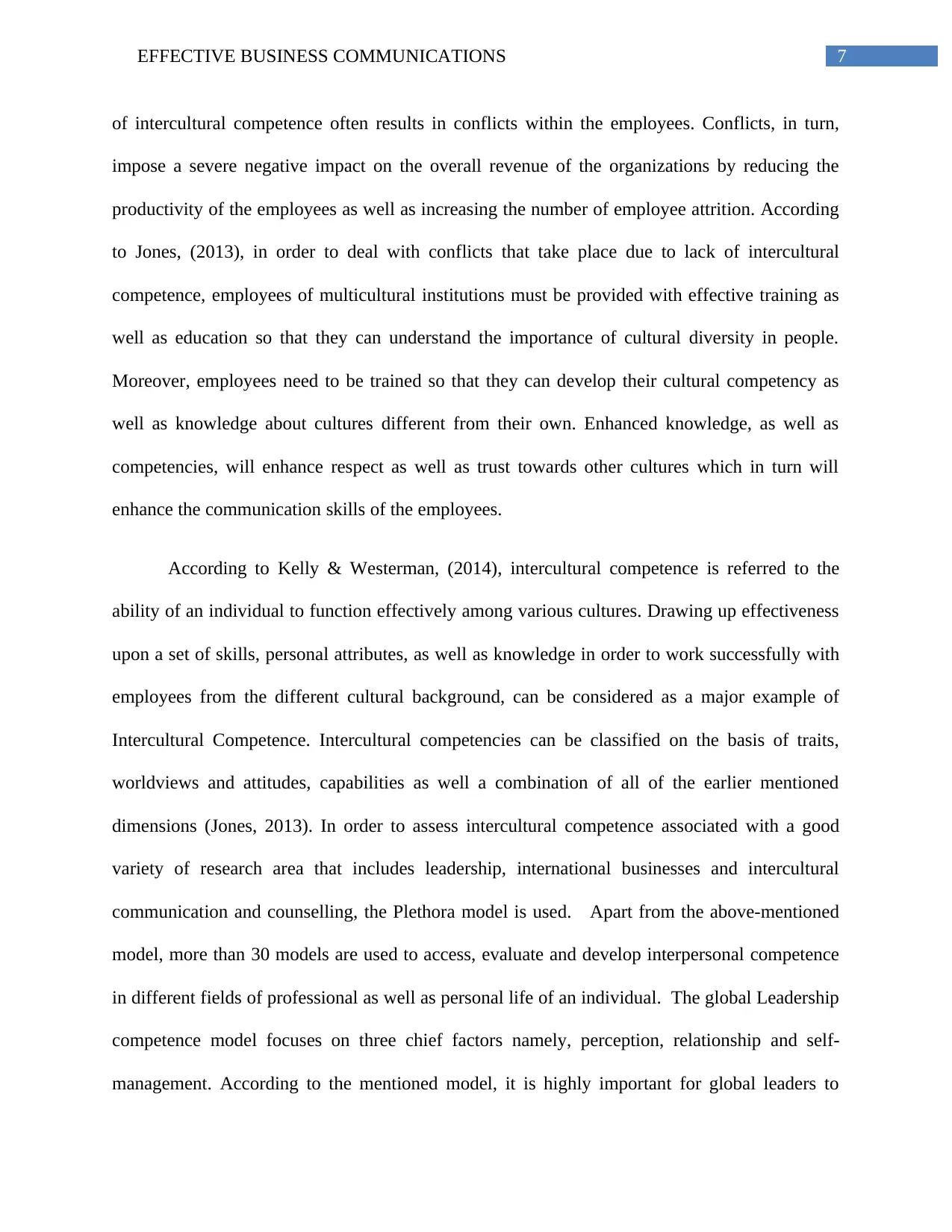
7EFFECTIVE BUSINESS COMMUNICATIONS
of intercultural competence often results in conflicts within the employees. Conflicts, in turn,
impose a severe negative impact on the overall revenue of the organizations by reducing the
productivity of the employees as well as increasing the number of employee attrition. According
to Jones, (2013), in order to deal with conflicts that take place due to lack of intercultural
competence, employees of multicultural institutions must be provided with effective training as
well as education so that they can understand the importance of cultural diversity in people.
Moreover, employees need to be trained so that they can develop their cultural competency as
well as knowledge about cultures different from their own. Enhanced knowledge, as well as
competencies, will enhance respect as well as trust towards other cultures which in turn will
enhance the communication skills of the employees.
According to Kelly & Westerman, (2014), intercultural competence is referred to the
ability of an individual to function effectively among various cultures. Drawing up effectiveness
upon a set of skills, personal attributes, as well as knowledge in order to work successfully with
employees from the different cultural background, can be considered as a major example of
Intercultural Competence. Intercultural competencies can be classified on the basis of traits,
worldviews and attitudes, capabilities as well a combination of all of the earlier mentioned
dimensions (Jones, 2013). In order to assess intercultural competence associated with a good
variety of research area that includes leadership, international businesses and intercultural
communication and counselling, the Plethora model is used. Apart from the above-mentioned
model, more than 30 models are used to access, evaluate and develop interpersonal competence
in different fields of professional as well as personal life of an individual. The global Leadership
competence model focuses on three chief factors namely, perception, relationship and self-
management. According to the mentioned model, it is highly important for global leaders to
of intercultural competence often results in conflicts within the employees. Conflicts, in turn,
impose a severe negative impact on the overall revenue of the organizations by reducing the
productivity of the employees as well as increasing the number of employee attrition. According
to Jones, (2013), in order to deal with conflicts that take place due to lack of intercultural
competence, employees of multicultural institutions must be provided with effective training as
well as education so that they can understand the importance of cultural diversity in people.
Moreover, employees need to be trained so that they can develop their cultural competency as
well as knowledge about cultures different from their own. Enhanced knowledge, as well as
competencies, will enhance respect as well as trust towards other cultures which in turn will
enhance the communication skills of the employees.
According to Kelly & Westerman, (2014), intercultural competence is referred to the
ability of an individual to function effectively among various cultures. Drawing up effectiveness
upon a set of skills, personal attributes, as well as knowledge in order to work successfully with
employees from the different cultural background, can be considered as a major example of
Intercultural Competence. Intercultural competencies can be classified on the basis of traits,
worldviews and attitudes, capabilities as well a combination of all of the earlier mentioned
dimensions (Jones, 2013). In order to assess intercultural competence associated with a good
variety of research area that includes leadership, international businesses and intercultural
communication and counselling, the Plethora model is used. Apart from the above-mentioned
model, more than 30 models are used to access, evaluate and develop interpersonal competence
in different fields of professional as well as personal life of an individual. The global Leadership
competence model focuses on three chief factors namely, perception, relationship and self-
management. According to the mentioned model, it is highly important for global leaders to
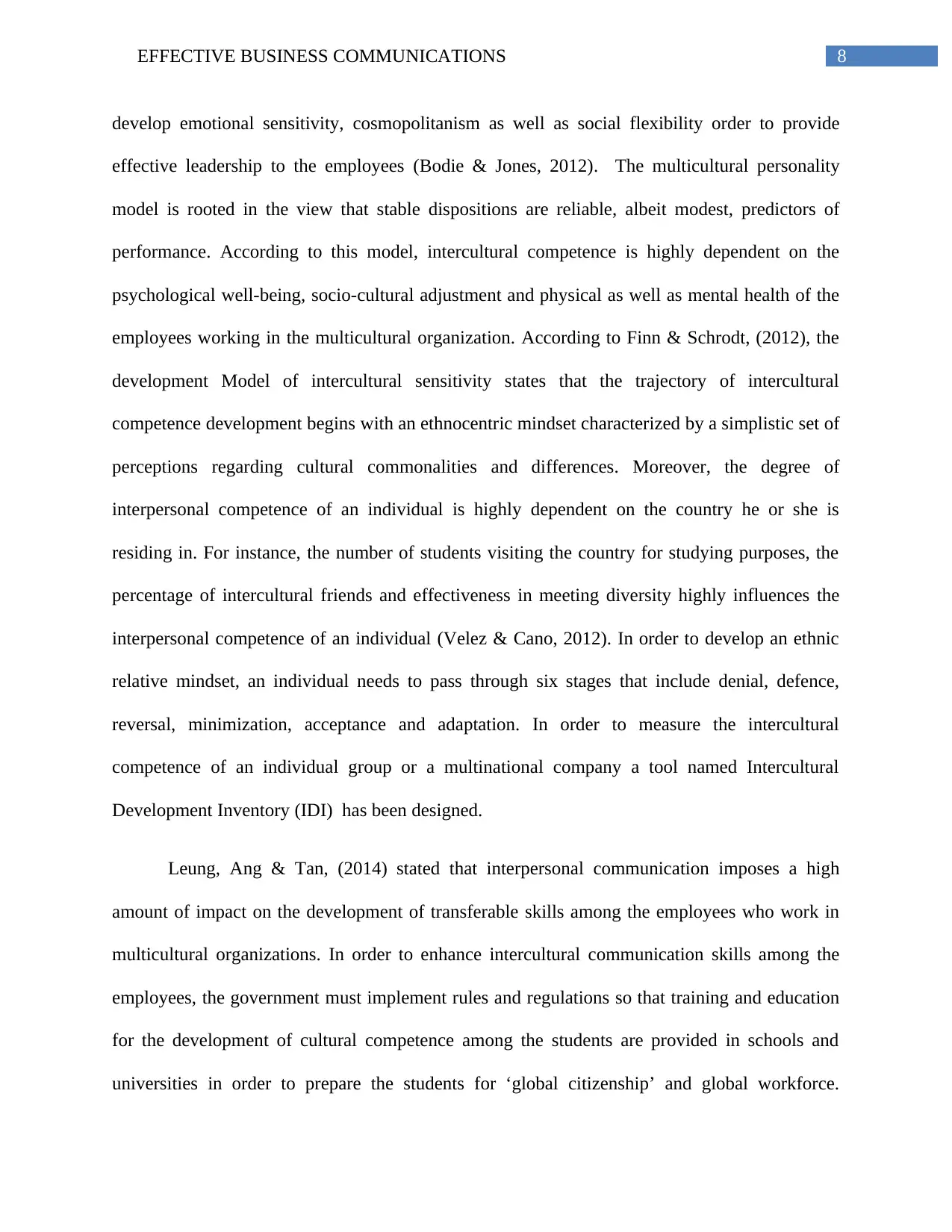
8EFFECTIVE BUSINESS COMMUNICATIONS
develop emotional sensitivity, cosmopolitanism as well as social flexibility order to provide
effective leadership to the employees (Bodie & Jones, 2012). The multicultural personality
model is rooted in the view that stable dispositions are reliable, albeit modest, predictors of
performance. According to this model, intercultural competence is highly dependent on the
psychological well-being, socio-cultural adjustment and physical as well as mental health of the
employees working in the multicultural organization. According to Finn & Schrodt, (2012), the
development Model of intercultural sensitivity states that the trajectory of intercultural
competence development begins with an ethnocentric mindset characterized by a simplistic set of
perceptions regarding cultural commonalities and differences. Moreover, the degree of
interpersonal competence of an individual is highly dependent on the country he or she is
residing in. For instance, the number of students visiting the country for studying purposes, the
percentage of intercultural friends and effectiveness in meeting diversity highly influences the
interpersonal competence of an individual (Velez & Cano, 2012). In order to develop an ethnic
relative mindset, an individual needs to pass through six stages that include denial, defence,
reversal, minimization, acceptance and adaptation. In order to measure the intercultural
competence of an individual group or a multinational company a tool named Intercultural
Development Inventory (IDI) has been designed.
Leung, Ang & Tan, (2014) stated that interpersonal communication imposes a high
amount of impact on the development of transferable skills among the employees who work in
multicultural organizations. In order to enhance intercultural communication skills among the
employees, the government must implement rules and regulations so that training and education
for the development of cultural competence among the students are provided in schools and
universities in order to prepare the students for ‘global citizenship’ and global workforce.
develop emotional sensitivity, cosmopolitanism as well as social flexibility order to provide
effective leadership to the employees (Bodie & Jones, 2012). The multicultural personality
model is rooted in the view that stable dispositions are reliable, albeit modest, predictors of
performance. According to this model, intercultural competence is highly dependent on the
psychological well-being, socio-cultural adjustment and physical as well as mental health of the
employees working in the multicultural organization. According to Finn & Schrodt, (2012), the
development Model of intercultural sensitivity states that the trajectory of intercultural
competence development begins with an ethnocentric mindset characterized by a simplistic set of
perceptions regarding cultural commonalities and differences. Moreover, the degree of
interpersonal competence of an individual is highly dependent on the country he or she is
residing in. For instance, the number of students visiting the country for studying purposes, the
percentage of intercultural friends and effectiveness in meeting diversity highly influences the
interpersonal competence of an individual (Velez & Cano, 2012). In order to develop an ethnic
relative mindset, an individual needs to pass through six stages that include denial, defence,
reversal, minimization, acceptance and adaptation. In order to measure the intercultural
competence of an individual group or a multinational company a tool named Intercultural
Development Inventory (IDI) has been designed.
Leung, Ang & Tan, (2014) stated that interpersonal communication imposes a high
amount of impact on the development of transferable skills among the employees who work in
multicultural organizations. In order to enhance intercultural communication skills among the
employees, the government must implement rules and regulations so that training and education
for the development of cultural competence among the students are provided in schools and
universities in order to prepare the students for ‘global citizenship’ and global workforce.
⊘ This is a preview!⊘
Do you want full access?
Subscribe today to unlock all pages.

Trusted by 1+ million students worldwide
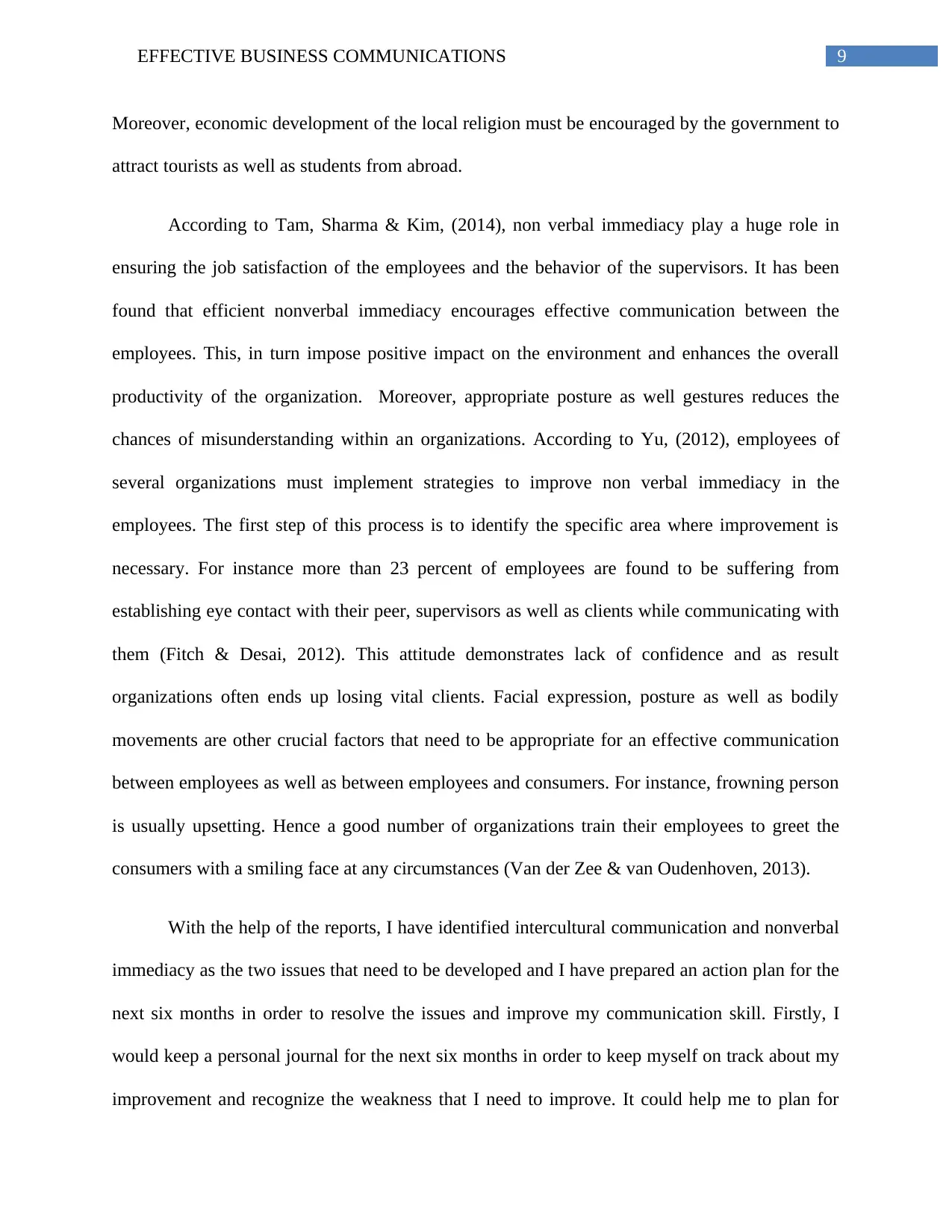
9EFFECTIVE BUSINESS COMMUNICATIONS
Moreover, economic development of the local religion must be encouraged by the government to
attract tourists as well as students from abroad.
According to Tam, Sharma & Kim, (2014), non verbal immediacy play a huge role in
ensuring the job satisfaction of the employees and the behavior of the supervisors. It has been
found that efficient nonverbal immediacy encourages effective communication between the
employees. This, in turn impose positive impact on the environment and enhances the overall
productivity of the organization. Moreover, appropriate posture as well gestures reduces the
chances of misunderstanding within an organizations. According to Yu, (2012), employees of
several organizations must implement strategies to improve non verbal immediacy in the
employees. The first step of this process is to identify the specific area where improvement is
necessary. For instance more than 23 percent of employees are found to be suffering from
establishing eye contact with their peer, supervisors as well as clients while communicating with
them (Fitch & Desai, 2012). This attitude demonstrates lack of confidence and as result
organizations often ends up losing vital clients. Facial expression, posture as well as bodily
movements are other crucial factors that need to be appropriate for an effective communication
between employees as well as between employees and consumers. For instance, frowning person
is usually upsetting. Hence a good number of organizations train their employees to greet the
consumers with a smiling face at any circumstances (Van der Zee & van Oudenhoven, 2013).
With the help of the reports, I have identified intercultural communication and nonverbal
immediacy as the two issues that need to be developed and I have prepared an action plan for the
next six months in order to resolve the issues and improve my communication skill. Firstly, I
would keep a personal journal for the next six months in order to keep myself on track about my
improvement and recognize the weakness that I need to improve. It could help me to plan for
Moreover, economic development of the local religion must be encouraged by the government to
attract tourists as well as students from abroad.
According to Tam, Sharma & Kim, (2014), non verbal immediacy play a huge role in
ensuring the job satisfaction of the employees and the behavior of the supervisors. It has been
found that efficient nonverbal immediacy encourages effective communication between the
employees. This, in turn impose positive impact on the environment and enhances the overall
productivity of the organization. Moreover, appropriate posture as well gestures reduces the
chances of misunderstanding within an organizations. According to Yu, (2012), employees of
several organizations must implement strategies to improve non verbal immediacy in the
employees. The first step of this process is to identify the specific area where improvement is
necessary. For instance more than 23 percent of employees are found to be suffering from
establishing eye contact with their peer, supervisors as well as clients while communicating with
them (Fitch & Desai, 2012). This attitude demonstrates lack of confidence and as result
organizations often ends up losing vital clients. Facial expression, posture as well as bodily
movements are other crucial factors that need to be appropriate for an effective communication
between employees as well as between employees and consumers. For instance, frowning person
is usually upsetting. Hence a good number of organizations train their employees to greet the
consumers with a smiling face at any circumstances (Van der Zee & van Oudenhoven, 2013).
With the help of the reports, I have identified intercultural communication and nonverbal
immediacy as the two issues that need to be developed and I have prepared an action plan for the
next six months in order to resolve the issues and improve my communication skill. Firstly, I
would keep a personal journal for the next six months in order to keep myself on track about my
improvement and recognize the weakness that I need to improve. It could help me to plan for
Paraphrase This Document
Need a fresh take? Get an instant paraphrase of this document with our AI Paraphraser
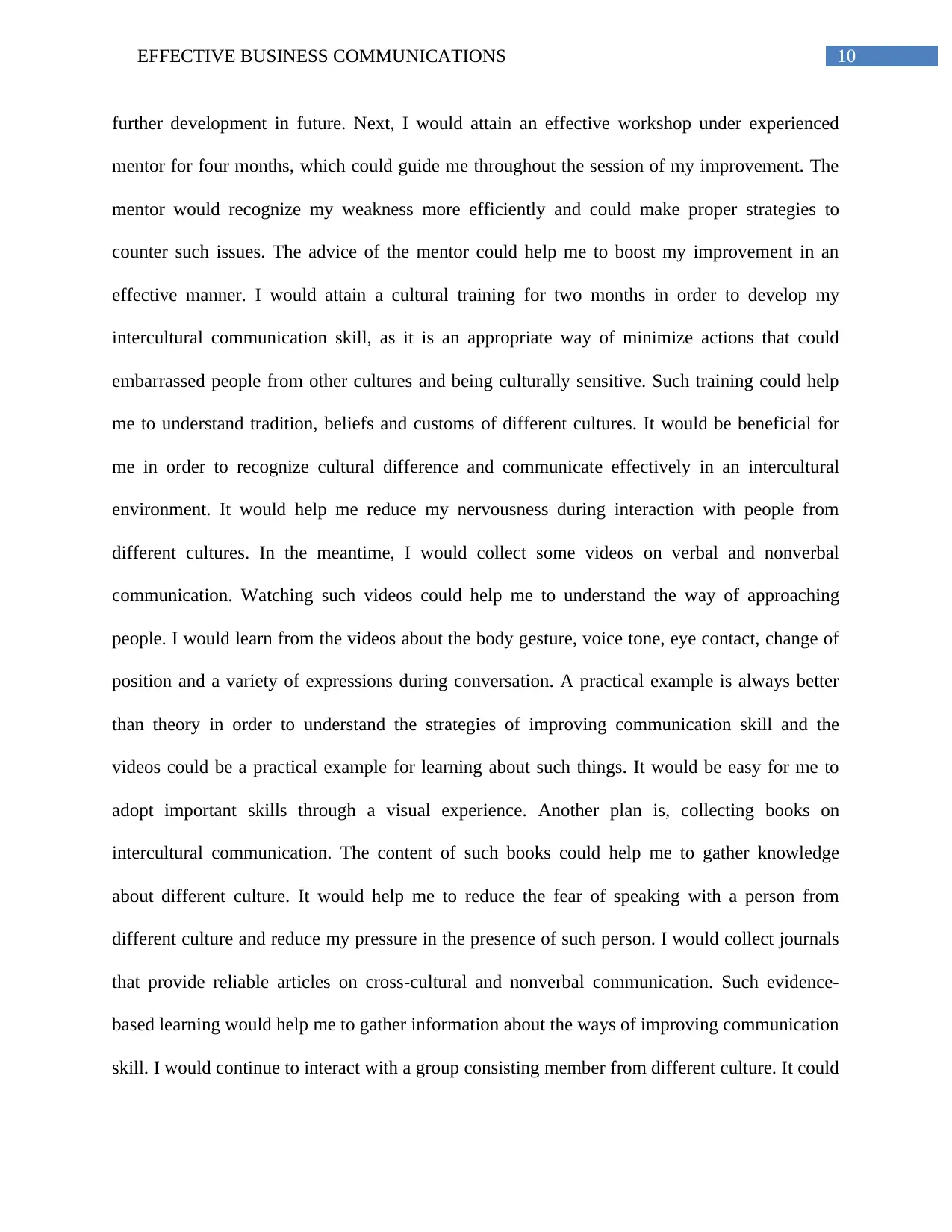
10EFFECTIVE BUSINESS COMMUNICATIONS
further development in future. Next, I would attain an effective workshop under experienced
mentor for four months, which could guide me throughout the session of my improvement. The
mentor would recognize my weakness more efficiently and could make proper strategies to
counter such issues. The advice of the mentor could help me to boost my improvement in an
effective manner. I would attain a cultural training for two months in order to develop my
intercultural communication skill, as it is an appropriate way of minimize actions that could
embarrassed people from other cultures and being culturally sensitive. Such training could help
me to understand tradition, beliefs and customs of different cultures. It would be beneficial for
me in order to recognize cultural difference and communicate effectively in an intercultural
environment. It would help me reduce my nervousness during interaction with people from
different cultures. In the meantime, I would collect some videos on verbal and nonverbal
communication. Watching such videos could help me to understand the way of approaching
people. I would learn from the videos about the body gesture, voice tone, eye contact, change of
position and a variety of expressions during conversation. A practical example is always better
than theory in order to understand the strategies of improving communication skill and the
videos could be a practical example for learning about such things. It would be easy for me to
adopt important skills through a visual experience. Another plan is, collecting books on
intercultural communication. The content of such books could help me to gather knowledge
about different culture. It would help me to reduce the fear of speaking with a person from
different culture and reduce my pressure in the presence of such person. I would collect journals
that provide reliable articles on cross-cultural and nonverbal communication. Such evidence-
based learning would help me to gather information about the ways of improving communication
skill. I would continue to interact with a group consisting member from different culture. It could
further development in future. Next, I would attain an effective workshop under experienced
mentor for four months, which could guide me throughout the session of my improvement. The
mentor would recognize my weakness more efficiently and could make proper strategies to
counter such issues. The advice of the mentor could help me to boost my improvement in an
effective manner. I would attain a cultural training for two months in order to develop my
intercultural communication skill, as it is an appropriate way of minimize actions that could
embarrassed people from other cultures and being culturally sensitive. Such training could help
me to understand tradition, beliefs and customs of different cultures. It would be beneficial for
me in order to recognize cultural difference and communicate effectively in an intercultural
environment. It would help me reduce my nervousness during interaction with people from
different cultures. In the meantime, I would collect some videos on verbal and nonverbal
communication. Watching such videos could help me to understand the way of approaching
people. I would learn from the videos about the body gesture, voice tone, eye contact, change of
position and a variety of expressions during conversation. A practical example is always better
than theory in order to understand the strategies of improving communication skill and the
videos could be a practical example for learning about such things. It would be easy for me to
adopt important skills through a visual experience. Another plan is, collecting books on
intercultural communication. The content of such books could help me to gather knowledge
about different culture. It would help me to reduce the fear of speaking with a person from
different culture and reduce my pressure in the presence of such person. I would collect journals
that provide reliable articles on cross-cultural and nonverbal communication. Such evidence-
based learning would help me to gather information about the ways of improving communication
skill. I would continue to interact with a group consisting member from different culture. It could
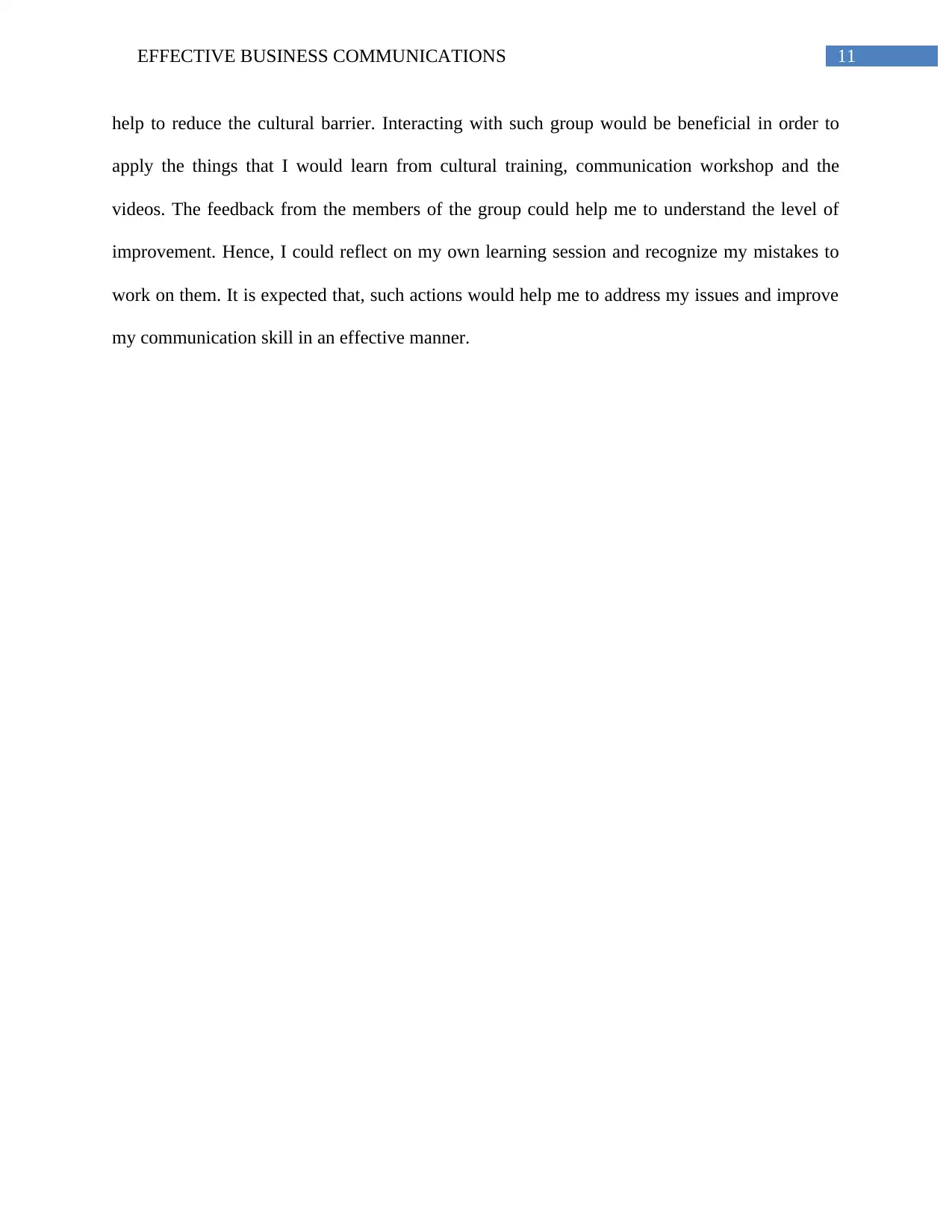
11EFFECTIVE BUSINESS COMMUNICATIONS
help to reduce the cultural barrier. Interacting with such group would be beneficial in order to
apply the things that I would learn from cultural training, communication workshop and the
videos. The feedback from the members of the group could help me to understand the level of
improvement. Hence, I could reflect on my own learning session and recognize my mistakes to
work on them. It is expected that, such actions would help me to address my issues and improve
my communication skill in an effective manner.
help to reduce the cultural barrier. Interacting with such group would be beneficial in order to
apply the things that I would learn from cultural training, communication workshop and the
videos. The feedback from the members of the group could help me to understand the level of
improvement. Hence, I could reflect on my own learning session and recognize my mistakes to
work on them. It is expected that, such actions would help me to address my issues and improve
my communication skill in an effective manner.
⊘ This is a preview!⊘
Do you want full access?
Subscribe today to unlock all pages.

Trusted by 1+ million students worldwide
1 out of 15
Related Documents
Your All-in-One AI-Powered Toolkit for Academic Success.
+13062052269
info@desklib.com
Available 24*7 on WhatsApp / Email
![[object Object]](/_next/static/media/star-bottom.7253800d.svg)
Unlock your academic potential
Copyright © 2020–2025 A2Z Services. All Rights Reserved. Developed and managed by ZUCOL.



